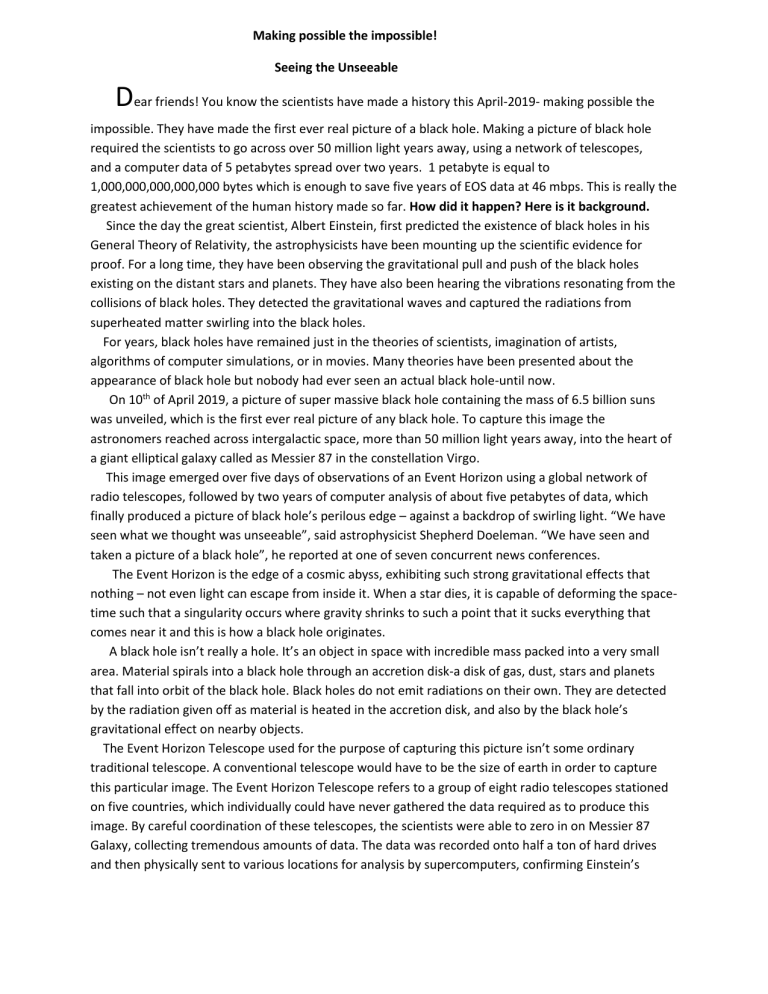
Making possible the impossible! Seeing the Unseeable Dear friends! You know the scientists have made a history this April-2019- making possible the impossible. They have made the first ever real picture of a black hole. Making a picture of black hole required the scientists to go across over 50 million light years away, using a network of telescopes, and a computer data of 5 petabytes spread over two years. 1 petabyte is equal to 1,000,000,000,000,000 bytes which is enough to save five years of EOS data at 46 mbps. This is really the greatest achievement of the human history made so far. How did it happen? Here is it background. Since the day the great scientist, Albert Einstein, first predicted the existence of black holes in his General Theory of Relativity, the astrophysicists have been mounting up the scientific evidence for proof. For a long time, they have been observing the gravitational pull and push of the black holes existing on the distant stars and planets. They have also been hearing the vibrations resonating from the collisions of black holes. They detected the gravitational waves and captured the radiations from superheated matter swirling into the black holes. For years, black holes have remained just in the theories of scientists, imagination of artists, algorithms of computer simulations, or in movies. Many theories have been presented about the appearance of black hole but nobody had ever seen an actual black hole-until now. On 10th of April 2019, a picture of super massive black hole containing the mass of 6.5 billion suns was unveiled, which is the first ever real picture of any black hole. To capture this image the astronomers reached across intergalactic space, more than 50 million light years away, into the heart of a giant elliptical galaxy called as Messier 87 in the constellation Virgo. This image emerged over five days of observations of an Event Horizon using a global network of radio telescopes, followed by two years of computer analysis of about five petabytes of data, which finally produced a picture of black hole’s perilous edge – against a backdrop of swirling light. “We have seen what we thought was unseeable”, said astrophysicist Shepherd Doeleman. “We have seen and taken a picture of a black hole”, he reported at one of seven concurrent news conferences. The Event Horizon is the edge of a cosmic abyss, exhibiting such strong gravitational effects that nothing – not even light can escape from inside it. When a star dies, it is capable of deforming the spacetime such that a singularity occurs where gravity shrinks to such a point that it sucks everything that comes near it and this is how a black hole originates. A black hole isn’t really a hole. It’s an object in space with incredible mass packed into a very small area. Material spirals into a black hole through an accretion disk-a disk of gas, dust, stars and planets that fall into orbit of the black hole. Black holes do not emit radiations on their own. They are detected by the radiation given off as material is heated in the accretion disk, and also by the black hole’s gravitational effect on nearby objects. The Event Horizon Telescope used for the purpose of capturing this picture isn’t some ordinary traditional telescope. A conventional telescope would have to be the size of earth in order to capture this particular image. The Event Horizon Telescope refers to a group of eight radio telescopes stationed on five countries, which individually could have never gathered the data required as to produce this image. By careful coordination of these telescopes, the scientists were able to zero in on Messier 87 Galaxy, collecting tremendous amounts of data. The data was recorded onto half a ton of hard drives and then physically sent to various locations for analysis by supercomputers, confirming Einstein’s statement “the silhouette of a black hole would look circular”, as it is seen in the picture. The data is still being analyzed by a group of astrophysicists for more discoveries. This was the first picture of a black hole ever taken, but, thrillingly, it won’t be likely the last one. Hopefully, soon we’ll be able to see what’s inside a black hole and what’s on the other side of it. Who knows, someday we discover wormholes as well, which is actually a theoretical passage through spacetime that could create shortcuts for long journeys across the universe. Maybe someday, as according to Stephen Hawking, “we’ll use black holes’ radiations as a source of unlimited energy. A mountain-sized black hole would give off X-rays and Gamma Rays, at a rate of about 10 million megawatts enough to power the world’s electricity supply”, said Stephen Hawking in a lecture. Maybe, someday we will find the truth of our existence.




